Papers by Pascal Le Masson
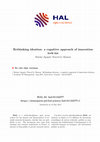
Proceedings - Academy of Management, 2015
Some industries are lacking the proposal of truly original new ideas to renew existing products a... more Some industries are lacking the proposal of truly original new ideas to renew existing products and/or services, despite repeated efforts from all stakeholders to make innovative and original proposals. These situations, called orphan innovation, lead to revisit the contemporary approaches to the study of obstacles in ideation, as orphan innovation is a paradoxical situation. Conventional financial constraints and institutional level are released, the market demand is strong, niche strategies are possible and bold entrepreneurs abound. And yet, the proposals do not fulfil expectations regarding innovation. We advocate in this paper that cognitive sciences can contribute to making sense of this phenomenon. Based on recent studies in cognitive psychology on idea generation, we propose a model of ideation reasoning, contrasting heuristic-based reasoning and exploration-based reasoning. We then apply this model on a case study, showing how a cognitive model of ideation allows to diagnose orphan innovation and more generally innovation lock-ins.
Psychology of Aesthetics, Creativity, and the Arts, Aug 1, 2015
HAL is a multidisciplinary open access archive for the deposit and dissemination of scientific re... more HAL is a multidisciplinary open access archive for the deposit and dissemination of scientific research documents, whether they are published or not. The documents may come from teaching and research institutions in France or abroad, or from public or private research centers. L'archive ouverte pluridisciplinaire HAL, est destinée au dépôt et à la diffusion de documents scientifiques de niveau recherche, publiés ou non, émanant des établissements d'enseignement et de recherche français ou étrangers, des laboratoires publics ou privés.
HAL (Le Centre pour la Communication Scientifique Directe), 2023
HAL is a multidisciplinary open access archive for the deposit and dissemination of scientific re... more HAL is a multidisciplinary open access archive for the deposit and dissemination of scientific research documents, whether they are published or not. The documents may come from teaching and research institutions in France or abroad, or from public or private research centers. L'archive ouverte pluridisciplinaire HAL, est destinée au dépôt et à la diffusion de documents scientifiques de niveau recherche, publiés ou non, émanant des établissements d'enseignement et de recherche français ou étrangers, des laboratoires publics ou privés.

HAL (Le Centre pour la Communication Scientifique Directe), Feb 1, 2013
ABSTRACT The proposed chapter deals with platform emergence in double unknown situations when tec... more ABSTRACT The proposed chapter deals with platform emergence in double unknown situations when technology and markets are highly uncertain. The interest in technological platform development to enable creation of products and processes that support present and future development of multiple options is widely recognized by practitioners and academics. The existing literature considers that platforms already invented and the development is mostly based on exploiting this common platform core to build future markets and technological derivatives. However, when we are in double unknown situations, markets and technologies are highly uncertain and neither market options, nor platform cores are known. Thus, how to start an exploration? How can one ensure platform emergence in double unknown? What are the market and technology conditions that lead to different strategies of platform emergence? To answer these questions, we formally describe identified strategies and fabricate simple economical model to compare them. We illustrate the insights of the model through a case study of innovative technology development in semiconductor industry. Our results allow for better understanding market and technological conditions that allow for minimization of risks and exploration costs in double unknown and exploration costs in double unknown. Following the principle of value creation across various applications, this work extends the comprehension of generic technology design in double unknown.
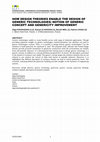
HAL (Le Centre pour la Communication Scientifique Directe), Aug 19, 2013
Generic technologies enable to create benefits across wide range of industrial applications. Thou... more Generic technologies enable to create benefits across wide range of industrial applications. Though providing important insights on generic technologies commercialization, less attention was paid to generic technologies creation. Then, is it possible to design directly generic technologies? Can the intention to build genericity be expressed ex ante? The proposed study indicates that formal design theories provide powerful mechanism of genericity construction when the environments are initially fixed and partially unknown. It is demonstrated that starting point to design generic technology is a generic concept. In addition to a concept definition proposed by C-K theory, the descriptors associated to the domain of existence were added. The generic concept targets the existence domains that are not reduced to one solution but several of them both known or partially unknown. Moreover, it is highlighted that different descriptors of existence domain can lead to various genericity levels. The economic reasoning behind the genericity building provides insights on the dynamics of engineering systems.

HAL (Le Centre pour la Communication Scientifique Directe), Jun 14, 2015
Firms that engage in open innovation (OI) activities seek to leverage on external knowledge to in... more Firms that engage in open innovation (OI) activities seek to leverage on external knowledge to innovate and use the open innovation intermediaries to conduct and structure their collaborative efforts. The access to external knowledge often requires an internal knowledge effort to be able to recognize, assimilate and use external knowledge which imply the organization of absorptive capacity (AC) function. Still, the absorption of isolated ideas in OI initiatives is a major issue. The purpose of this research is to investigate how the OI intermediaries ensure the AC for firms participating in the OI through the process of searching and integrating knowledge created through the innovation process. Through an exploratory case study of an intermediary platform that connects the technical experts throughout the world – IdexLab and its clients, we investigate IdexLab’s capacity to prepare and conduct the AC activity based on “novelty search” algorithms. We find that the OI platform can incorporate function to automatize the AC and facilitate further diffusion of ideas.
HAL (Le Centre pour la Communication Scientifique Directe), 2017
International audienc

ABSTRACT ignorance of which one among many possible technologies is most likely to emerge and sim... more ABSTRACT ignorance of which one among many possible technologies is most likely to emerge and similar ignorance of which one among many possible applications will most likely be a driver for the technology. Generic technologies are widely recognized to be beneficial for various market applications and recent research results show that double unknown can lead companies to organize design activity to develop generic technologies suitable for several emerging markets application. However, the investigations so far focused on the level of the individual firm, while a “double unknown” situation is typically characterizing an industrial sector as a whole. This is in particular the case of the semiconductor industry: While the International Technology Roadmap for Semiconductors (ITRS) primary focus has been and still is the continuation of Moore’s law, it introduced recently the “More than Moore” concept, to account for technologies which do not necessarily follow the CMOS miniaturization trends, and represent a growing part of the total silicon-based semiconductor market. The sheer diversity of both those technologies and their potential applications renders a roadmapping exercise very challenging. Nevertheless, given the benefits that roadmapping has brought to the semiconductor industry, the International Roadmap Committee (IRC) of the ITRS has decided to extend its activities to this new field. Which strategies do the ITRS experts implement to select which technologies to roadmap and which applications to target in double unknown? In this paper, we show that to design roadmaps for More than Moore technologies, the ITRS experts apply a strategy of “common unknown”, along with additional community building activities specific to the situation of inter-firm collaboration.
Research Policy, Nov 1, 2023
RePEc: Research Papers in Economics, 2020
Distribution électronique Cairn.info pour Lavoisier. © Lavoisier. Tous droits réservés pour tous ... more Distribution électronique Cairn.info pour Lavoisier. © Lavoisier. Tous droits réservés pour tous pays. La reproduction ou représentation de cet article, notamment par photocopie, n'est autorisée que dans les limites des conditions générales d'utilisation du site ou, le cas échéant, des conditions générales de la licence souscrite par votre établissement. Toute autre reproduction ou représentation, en tout ou partie, sous quelque forme et de quelque manière que ce soit, est interdite sauf accord préalable et écrit de l'éditeur, en dehors des cas prévus par la législation en vigueur en France. Il est précisé que son stockage dans une base de données est également interdit.
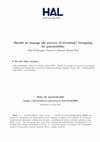
RePEc: Research Papers in Economics, 2017
The IP design is often neglected by the management literature, whereas the issue of the strategic... more The IP design is often neglected by the management literature, whereas the issue of the strategic IP management begins with IP creation. This paper intends to deal with IP as an asset to be designed and focuses on IP design by ensuring novelty and inventive step of the inventions and not their quantity. By building on the most recent design theories like Conceot Knowledge design theory, this research introduces a general framework of patent design that allows controlling for "patentability" criteria, describe a patent in a unique way using actions, effects and associated knowledge and consider reasoning of person skilled in the art. Using the introduced model, the existing patent design methods are compared and their performance characterized using an introduced patent design model. The results show that patent proposal quality depends on the capacity to extend the existing knowledge combinations; to overcome the initial design reasoning of person skilled in the art and ensure sufficient inventive step and novelty. Finally, the patent design model actually demonstrates that there is an unexplored property of design theories-non-substitution-showing that the order in design is irreversible and influences the quality of results.
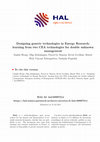
HAL (Le Centre pour la Communication Scientifique Directe), Jun 4, 2014
The aim of this paper is to shed light on an innovative strategy for the design of generic techno... more The aim of this paper is to shed light on an innovative strategy for the design of generic technologies (GTs). Research on radical innovation management, while recognizing the success of GTs, generally describes their design according to evolutionary strategies featuring multiple and uncertain trials, which would finally result in the discovery of common features between multiple applications. Building on a case study conducted on two technological development programs at the French Alternative Energies and Atomic Energy Commission (CEA), we exhibit an anomaly to this rarely discussed idea: we describe an alternative strategy that consists in intentionally designing common features that bridge the gap between a priori heterogeneous applications and a priori heterogeneous technologies. This anomaly brings three main results: 1) The usual trial-and-learning strategy is not necessarily the only strategy to design a GT; 2) beyond technological breakthrough, the value of GTs also relies on the capacity to reuse and connect existing technologies; 3) the design of GT might require sophisticated organizational patterns to be able to involve multiple technology suppliers and applications' providers.

RePEc: Research Papers in Economics, 2009
ABSTRACT In literature and R&D organizations alike, project success consists in minimizin... more ABSTRACT In literature and R&D organizations alike, project success consists in minimizing the deviations from set targets in terms of quality, cost and time. The main management task is to execute and monitor progress to reduce risks – assuming that project attributes are known, necessary resources can be estimated and a reasonable time table can be agreed upon. In such a context, evaluating project success is easy. However, in an innovative context, setting project targets initially is difficult and the contributions of the projects sometimes are of an unexpected nature. This paper investigates if projects can be evaluated in terms of how they contribute to the building of innovative capabilities of the firm instead of independently. Based on a case study at the Régie Autonome des Transports Parisians and the theoretical framework of innovation fields, a framework for evaluating projects from an additional perspective is proposed. Based on the following four criteria: financial resources, the development of a structured, refined and expanded strategic vision, developed competences (with related suppliers) and identification of knowledge gaps (occasionally with related partners for knowledge production), this framework shows how seemingly failed R&D projects can instead be considered as invaluable to the overall innovation process.

Creativity and Innovation Management, Jul 6, 2016
The objective of this paper is to elucidate an organizational process for the design of generic t... more The objective of this paper is to elucidate an organizational process for the design of generic technologies (GTs). While recognizing the success of GTs, the literature on innovation management generally describes their design according to evolutionary strategies featuring multiple and uncertain trials, resulting in the discovery of common features among multiple applications. This random walk depends on multiple market and technological uncertainties that are considered exogenous: as smart as he can be, the ‘gambler’ must play in a given probability space. However, what happens when the innovator is not a gambler but a designer, i.e., when the actor is able to establish new links between previously independent emerging markets and technologies? Formally speaking, the actor designs a new probability space. Building on a case study of two technological development programmes at the French Center for Atomic Energy, we present cases of GTs that correspond to this logic of designing the probability space, i.e. the logic of intentionally designing common features that bridge the gap between a priori heterogeneous applications and technologies. This study provides another example showing that the usual trial-and-learning strategy is not the only strategy to design GTs and that these technologies can be designed by intentionally building new interdependences between markets and technologies. Our main result is that building these interdependences requires organizational patterns that correspond to a ‘design of exploration’ phase in which multiple technology suppliers and application providers are involved in designing both the probability space itself and the instruments to explore and benefit from this new space.
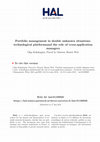
Creativity and Innovation Management, May 31, 2015
This article investigates portfoliomanagement in double unknown situations. Double unknown refers... more This article investigates portfoliomanagement in double unknown situations. Double unknown refers toa situation in which the level of uncertainty is high and both technology and markets are as-yet-unknown. This situation can be an opportunityfor new discoveries, creation of new performance solutions and giving direction to portfolio structuring. The literature highlights that the double unknown situation is a prerequisite to designinggeneric technologies that are able to address many existing and emerging markets and create value across a broad range of applications. The purpose of this paper is to investigatethe initial phases of generic technology governance and associated portfolio structuring in multi-project firms.We studiedthree empirical contexts of portfolio structuring at the European Semiconductor provider STMicroelectronics. The results demonstrate that 1) portfolio management for generic technologies is highly transversal and comprises creating both modules to address market complementarities and the core element of a technological systemthe platform and 2) the design of generic technologies requires "cross-application" managers who are able to supervise the interactions among innovative concepts developed in different business and research groups and who are responsible for structuring and managing technological and marketing exploration portfolios within the organizational structures of a company.
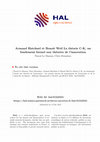
HAL (Le Centre pour la Communication Scientifique Directe), 2016
Un chapitre sur Armand Hatchuel et Benoit Weil et sur la théorie la théorie C-K 1 dont ils sont l... more Un chapitre sur Armand Hatchuel et Benoit Weil et sur la théorie la théorie C-K 1 dont ils sont les auteurs s'imposait : leurs propositions scientifiques sont discutées et publiées dans toutes les communautés qui comptent pour le management de l'innovation-engineering design, industrial design, management, économie, philosophie, sociologie, histoire, etc. Leurs travaux embrassent les aspects les plus fondamentaux des raisonnements génératifs, les aspects neuropsychologiques de la création, les questions de méthodes et d'organisation pour l'innovation, la gouvernance des entreprises innovantes, la dynamique des écosystèmes industriels, la question des professions créatives,... Ils allient légitimité scientifique, industrielle et sociopolitique. Et ils inspirent de nombreux travaux de recherche à travers le monde, dans les disciplines les plus variées. Ce succès tient notamment au parti qu'ils ont pris il y a près de vingt ans d'aborder les questions d'innovation à partir de l'activité collective qui en est la source, la conception, et d'aborder cette activité de conception à partir d'une théorie aussi universelle que possible du raisonnement de conception. Ce chapitre rend compte de cette démarche, en précisant d'abord le contexte initial des travaux, contexte aussi bien industriel que scientifique, puis en présentant les traits principaux de la théorie C-K et les espaces intellectuels qu'elle ouvre et en indiquant finalement les principaux impacts de la théorie C-K. Ce faisant, on ne prétendra pas rendre compte ici de l'ensemble des travaux des deux auteurs. En se focalisant sur la conception on négligera les travaux sur l'épistémologie et les fondements des sciences de gestion, les travaux sur les systèmes de production, sur l'intelligence artificielle et la gestion des connaissances, les apports en GRH, en économie ou en sociologie. Toutefois le travail sur la conception illustre deux idées fondamentales, au coeur de tous ces travaux : 1-il importe de revenir aux formes de raisonnement pour comprendre, étudier voire inventer les formes nouvelles de l'action collective (voir à ce sujet la théorie des mythes rationnels et les rationalisations (Hatchuel et Molet 1986 ; Hatchuel 1996 ; Hatchuel
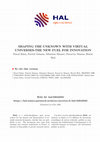
HAL (Le Centre pour la Communication Scientifique Directe), 2020
The new logic of financing innovation: from uncertainty reduction to shaping the unknown Handbook... more The new logic of financing innovation: from uncertainty reduction to shaping the unknown Handbooks in finance, as well as literature reviews, recall that financing innovation and financing productivity investment differ in their level of uncertainty. 1 Students learn that financing production investment requires a positive net present value (NPV), whereas financing innovation requires taking into account multiple uncertainties by computing expected NPV. Models of decision-making in uncertainty helped to compute the value of reducing uncertainty. 2 This approach is considered the best way to value investment in research and development (R&D)-R&D being considered an activity to reduce uncertainty. 3 In this time of "disruptive innovation" in the context of multiple socioeconomic and technological changes-such as energy transition, aging, and digitalization-it is tempting to consider that innovation dynamics tend to be characterized by an increase in uncertainty. Investments would, therefore, become much riskier, and financing might seem almost impossible. Fortunately, this "wisdom" misses a critical feature of contemporary innovation: it is not mainly about uncertainty but much more about "the unknown". In contemporary innovation, one has to deal not only with uncertain events, such as unstable markets and technological advances, but also partially unknown chimeras, such as inclusive mobility, smart cities, and sustainable energy. Therefore, it is critical for innovation success to deal with these initially unknown situations and shape them in a beneficial direction. 4 This distinction between uncertain and unknown has major consequences on innovation investment: the financing approach must not only consist of reducing uncertainty but also of shaping the unknown, i.e., through a capacity to design new alternatives, worlds, opportunities, markets, and usages.

HAL (Le Centre pour la Communication Scientifique Directe), Jun 18, 2014
Patents play an ever-increasing role in the modern economies and are often used as a measure of t... more Patents play an ever-increasing role in the modern economies and are often used as a measure of technology innovativeness. This paper deals with the innovative field exploration where companies are constantly under pressure to generate high quality patents that will ensure future firms growth, their survival and protect their inventions. This work builds on the existing methods of patent modeling that appear to be adapted for disruptive innovation. By drawing on the patentability criteria, their interpretation in the patent model driven by the design theory frameworks like Concept-Knowledge theory, the paper examines the means of applicability of these methods within the high-velocity industries like semiconductors or nanotechnologies. As a result, two processes of patent design are exhibited: 1) technology design that brings to define patent proposals or 2) patent proposals design that add new innovative attributes prior to technology creation. The insights are given on which approach companies have to pursue regarding their problematic.

HAL (Le Centre pour la Communication Scientifique Directe), Jun 3, 2014
ABSTRACT The circumstances in which firms operate have moved towards novel and unknown environmen... more ABSTRACT The circumstances in which firms operate have moved towards novel and unknown environments, thereby fundamentally modifying the logic of decision making, rendering planning approaches inadequate. The literature highlights that in these situations companies have to adapt more flexible approaches, to incorporate learning and privilege interactions among projects and corresponding environment. Moreover, sector dynamic influences the choice of strategies under high uncertainty. There are sectors "pushed" by technologies or "pulled" by markets. In the situations of double technology and markets unknowns an interesting solution is highlighted: the design of technological platform that is able to address many emerging markets. Yet it is not self-evident when these strategies are advantageous for the firms that are subject of the environmental dynamics and pursuing double unknown. A simulation study is carried out to clarify the contingent criteria in which the exploration of multiple technologies and markets could lead to platform design. The conducted simulation experiment reveals two main contingent variables: the existence of market signals and the "segregative" or "aggregative" nature of technological systems. The study endeavors to provide an improved theoretical understanding of double unknown management and the corresponding strategies.
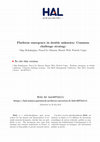
HAL (Le Centre pour la Communication Scientifique Directe), May 23, 2012
Context and Research questions The proposed paper deals with platform emergence in double unknown... more Context and Research questions The proposed paper deals with platform emergence in double unknown situations when technology and markets are highly uncertain. The interest in technological platform development to enable creation of products and processes that support present and future development of multiple options is widely recognised by practitioners and academics (Gawer 2009, Baldwin 2008, Baldwin and Clark 1997, Meyer and Utterback 1993, etc). The existing literature considers already existing platforms and the development is based on exploiting this common platform core to build future markets and technological derivatives. However, when we are in double unknown situations, markets and technologies are highly uncertain and neither options, nor platform core are known. Thus, how can one ensure platform emergence in double unknown?

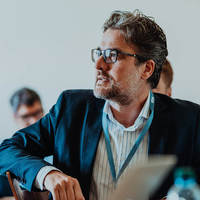









Uploads
Papers by Pascal Le Masson